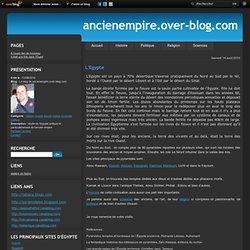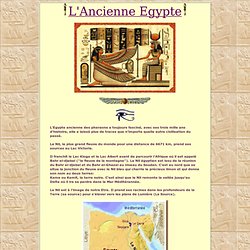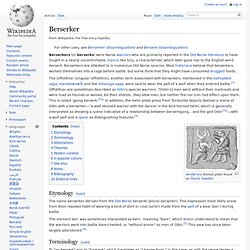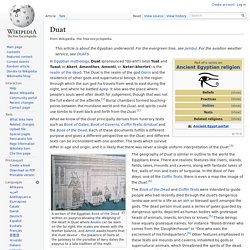

Egypte. Ancient Egyptian scripts (hieroglyphs, hieratic and demotic) Origins of Egyptian Hieroglyphs The ancient Egyptians believed that writing was invented by the god Thoth and called their hieroglyphic script "mdju netjer" ("words of the gods").

The word hieroglyph comes from the Greek hieros (sacred) plus glypho (inscriptions) and was first used by Clement of Alexandria. The earliest known examples of writing in Egypt have been dated to 3,400 BC. The latest dated inscription in hieroglyphs was made on the gate post of a temple at Philae in 396 AD. The hieroglyphic script was used mainly for formal inscriptions on the walls of temples and tombs. After the Emperor Theodsius I ordered the closure of all pagan temples throughout the Roman empire in the late 4th century AD, knowledge of the hieroglyphic script was lost. decipher the script.
Decipherment Many people have attempted to decipher the Egyptian scripts since the 5th century AD, when Horapollo provided explanations of nearly two hundred glyphs, some of which were correct. Notable features Numerals. Ancient Egyptian Mythology.
Pyramid Texts Online. Papyrus of Ani: The Egyptian Book of the Dead. Egyptian Mythology. Egyptian Mythology. Napata.org. L'Egypte - Le blog de l'Ancien Empire. Samedi 14 août 2010 6 14 /08 /Août /2010 00:14 L'Egypte est un pays à 70% désertique traversé pratiquement du Nord au Sud par le Nil, bordé à l'Ouest par le désert Libyen et à l'Est par le désert du Sinaï.

La bande étroite formée par le fleuve est la seule partie cultivable de l'Egypte. Elle lui doit tout. En effet le fleuve, jusqu'à l'inauguration du barrage d'Assouan dans les années 60, faisait bénéficier la terre stérile du désert des inondations périodiques annuelles et déposait son lot de limon fertile. Les pluies abondantes du printemps sur les hauts plateaux Ethiopiens arrachaient tous les ans le limon pour le redéposer plus en aval le long des bords du fleuve. Sur ces rives était, pour les anciens, la terre des vivants et au delà, était la terre des morts sur la rive Ouest.
Du Nord au Sud, on compte plus de 90 pyramides réparties sur plusieurs sites, qui sont les tombes des souverains des ancien et moyen empires. Les sites principaux de pyramides sont : Références : Digital Egypt for Universities. EGYPTE ANTIQUE par Françoise Nottoli. Au pays d'HATHOR. Fruit of the Nile. Égypte - Egypt : Nouvelle description de L'Égypte. L Egypte en Majeste. NUBIE PAR NEFERCOCO. Das alte Ägypten, Reise, Bücher, Blog - Selket's Ägypten. Egyptology News. Virtual-Egypt - The Egyptian People's Papyrus. Passion - Égypte. Désir d'Egypte. Égyptologie. Ancienne Égypte. Égyptologie. Ancienne Égypte.
Ancienne Egypte - Nil. Entre 8000 et 5000 avant J.C. de nombreuses populations s'installent le long de la Haute et de la Basse Égypte : ce sont des peuples venant de l'Asie, du centre de l'Afrique et de l'Occident, survivants de l'Atlantide.

Telle était, dans l'antiquité égyptienne, la conception, ou plutôt une des conceptions de la naissance du monde. L'Egypte par Fabrice Mrugala. L'égypte un don du Nil. Valley of the Golden Mummies - Dr. Zahi Hawass. Kemet. Wonders of Ancient Egypt / Nekhebet. Ancient Egypt and Archaeology Web Site. Ancient Egypt. Ancient Egypt Page. Ancient Egyptian scripts (hieroglyphs, hieratic and demotic)
Divine Felines: Cats of Ancient Egypt.
Eg. History. Berserker. Berserkers (or berserks) were Norse warriors who are primarily reported in the Old Norse literature to have fought in a nearly uncontrollable, trance-like fury, a characteristic which later gave rise to the English word berserk.

Berserkers are attested to in numerous Old Norse sources. Most historians believe that berserkers worked themselves into a rage before battle, but some think that they might have consumed drugged foods. The Úlfhéðnar (singular Úlfheðinn), another term associated with berserkers, mentioned in the Vatnsdœla saga, Haraldskvæði and the Völsunga saga, were said to wear the pelt of a wolf when they entered battle.[1] Úlfhéðnar are sometimes described as Odin's special warriors: "[Odin’s] men went without their mailcoats and were mad as hounds or wolves, bit their shields...they slew men, but neither fire nor iron had effect upon them. Etymology[edit] The name berserker derives from the Old Norse berserkr (plural berserkir). Terminology[edit] Attestations[edit]
Duat. This article is about the Egyptian underworld.

For the evergreen tree, see Jambul. For the aviation weather service, see DUATS. In Egyptian mythology, Duat (pronounced "do-aht") (also Tuat and Tuaut or Akert, Amenthes, Amenti, or Neter-khertet) is the realm of the dead. The Duat is the realm of the god Osiris and the residence of other gods and supernatural beings. It is the region through which the sun god Ra travels from west to east during the night, and where he battled Apep.
What we know of the Duat principally derives from funerary texts such as Book of Gates, Book of Caverns, Coffin Texts, Amduat and the Book of the Dead. Ancient Egypt - Menu page.